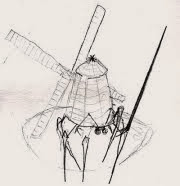Deinonychus and the raptors tend to stick in my mind, because like Stegosaurus or Ankylosaurus, they are just so damned flamboyant. It seems odd to me that predators ranging from 10 lbs to 160lbs ( a 10X scale increase) would use exactly the same very specialized prey assault technique.
Today I had the image of a row of Velociraptors hanging from a branch like bats.
Maybe the claw was a climbing claw, but not for huge herbivores: actually for huge herbs?
Nearly all of the raptors fit in the weight class of the puma/cougar/jaguar which are modern large tree-philic predators. The tree-climbing would also explain the stiff tail, fused to prevent motion in a vertical plane.
Woodpeckers and sapsuckers prop themselves on their tails while hanging from trees. Could the raptors hang themselves from their claws, prop themselves on their tails, and wait for prey, with minimal energy expenditure? The strong front legs and long grasping fingers would be very useful for this role as well.
If this were the case, there should be signs:
The muscle attachments for the talon claw would be robust.
The talons themselves would show wear inside the inside edge. The wear on the tip would probable the same in either case.
A semi-arboreal species would have strong pressure to develop gliding of flying abilities.
Microraptor has already been suggested for this role, but I am willing to expand the possibilities.
Utahraptor could be argued as the antithesis to this - at 1200lbs, its not climbing trees. But, like the Giant Ground Sloth, its quite possible that the creature adapted to a changing role, and became a forest floor monster, padding through the trees in search of prey, its sleeping dreams disturbed by strange desires to hang head down in the moonlight
Upon some googling, I find Manning et al. (2005) suggest that the claws would be more effective for climbing than killing.
Subscribe to:
Post Comments (Atom)


No comments:
Post a Comment